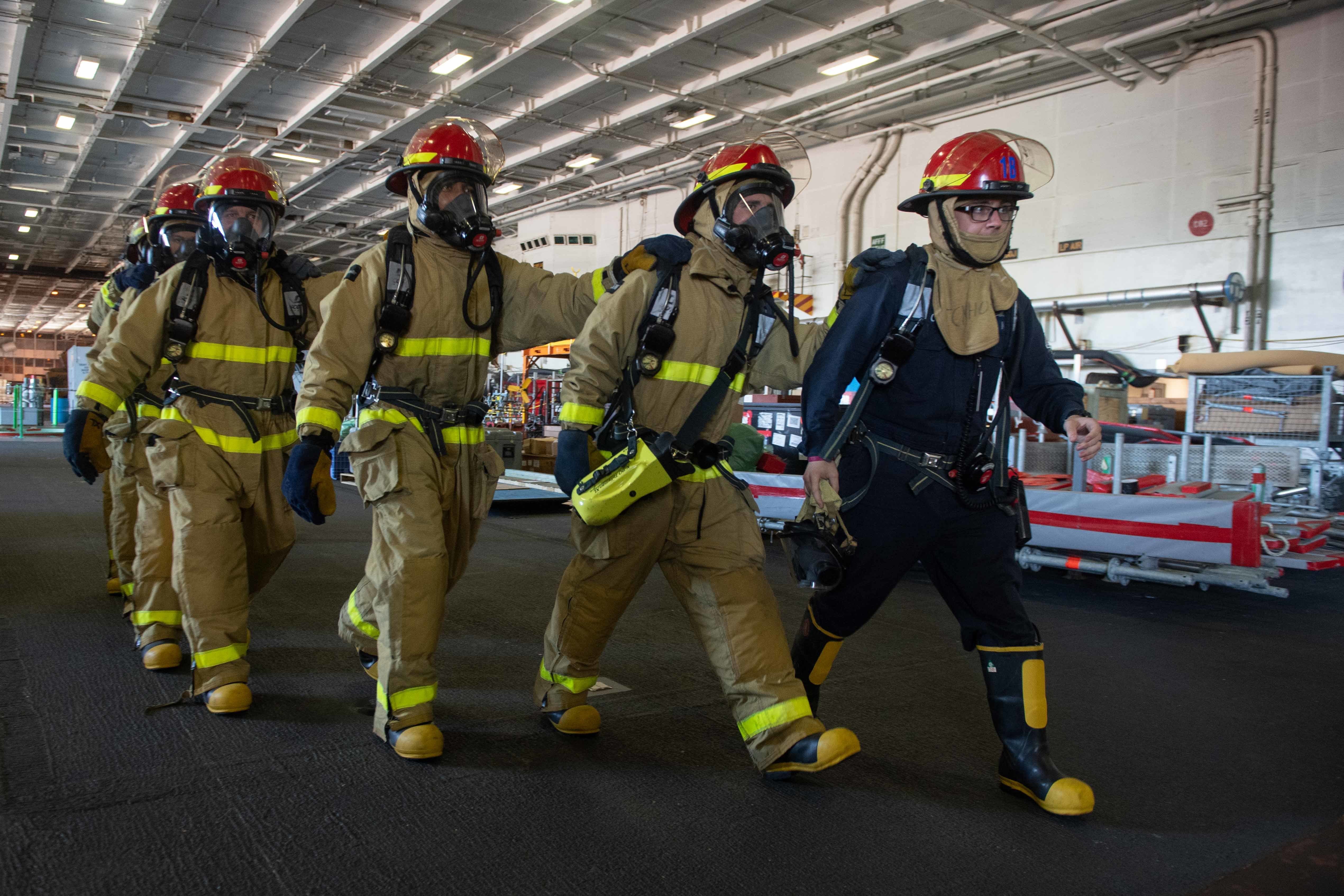
After losing an amphibious warship to a fire, the Navy will elevate the head of service safety to a two-star billet and create a new oversight board meant to improve fire safety throughout the fleet.
In response to findings from a Navy investigation into the fire aboard the former USS Bonhomme Richard (LHD-6) and multiple fires aboard other ships in the last few years, the service will have the elevated two-star billet take charge of the non-nuclear surface force safety standards and report directly to the Chief of Naval Operations, Vice Chief of Naval Operations Adm. Bill Lescher told reporters on Wednesday.
In addition, Lescher has established an oversight board to help identify changes to improve the fire safety posture of the service.
The Learning to Action Board “is similar in function to the Readiness Reform Oversight Council (RROC), established after the Fitzgerald and McCain investigations. However, it is different in that it is designed to be an enduring body, enabling the L2AB to test whether recommendations remain in effect over time and whether the recommendations are having their intended effect,” reads a Navy statement provided to USNI News.
The board will be chaired by the VCNO and the Navy Undersecretary and includes the assistant navy secretaries of Energy, Installations and Environment and Navy, Manpower and Reserve Affairs, as well as the commanders of Fleet Forces, PACFLEET, Naval Forces Europe and the director of the Navy staff.
The changes come as the Navy has found crews of warships in repair periods across the fleet aren’t properly prepared to handle fires while in port, according to a Navy study into 15 ship fires released in conjunction with the investigation into the July 12, 2020 fire on the former Bonhomme Richard (LHD-6).
The Major Fires Report, conducted by U.S. Pacific Fleet and U.S. Fleet Forces, studied ship fires in the service following the loss of the nuclear attack submarine USS Miami (SSN-755) in 2012 and the institution of a new set of instructions to train crews on how to handle fire in maintenance, the NAVSEA Technical Publication, Industrial Ship Safety Manual for Fire Prevention and Response, also known as the 8010 manual.
“We saw that our ships meet high firefighting standards at sea, but when they transition to-and-from the maintenance phase, they face different hazards and challenges,” Vice Chief of Naval Operations Adm. Bill Lescher told reporters on Wednesday. “Most of our commanders and crew tackle these successfully but some clearly struggle.”
At sea, the Navy trains to fight fires with the whole crew aboard and all the equipment needed to tackle a blaze while working. However, during maintenance sections are spread out with smaller groups of sailors aboard with degraded equipment and spaces that can be jammed with equipment needed for the maintenance work – circumstances the 8010 manual was created to mitigate.
In the case of Bonhomme Richard, 87 percent of their firefighting stations were offline and the crew “had a general unfamiliarity with the content of the 8010 Manual and commented that their training had not prepared them to combat a fire of the magnitude having occurred,” according to the command investigation.
In addition to Miami and Bonhomme Richard, for the larger review investigators evaluated fires aboard USS Abraham Lincoln (CVN-72), USS Carl Vinson (CVN-70), USS George Washington (CVN-73), USS Iwo Jima (LHD-7), USS Boxer (LHD-4), USS Oscar Austin (DDG-79), USS Chosin (CG-65), USS Whidbey Island (LSD-41), USS Hue City (CG-66), USS McCampbell (DDG-85), USS Gunston Hall (LSD-42), USS Ardent (MCM-12) and USS Champion (MCM-4).
In looking across the Navy, investigators “found that the training continuum adequately prepares crews to combat underway fires but leaves crews unprepared to respond to fires while in port, particularly with only the duty section onboard. The [report] also found that insufficient integrated training resulted in dysfunctional incident command and control.”
The common thread for most of the fires was that the ships were in maintenance.
“Of the events reviewed, 13 of the 15 occurred during depot-level or unit-level maintenance with six of the fires resulting from a significant violation of established fire safety requirements or indirectly caused or increased in severity by ongoing maintenance efforts,” reads the report.
“One incident occurred in a public shipyard and three in private shipyards. Six involved contracted maintenance activity or their presence onboard during the fire or events that directly preceded the fires. Only two of 15 events occurred while underway conducting normal operations.”
Other changes on the waterfront are already underway.
Naval Surface Force commander Vice Adm. Roy Kitchener told reporters in July that his command had added additional fire marshalls to assess crew firefighting skills and invested in additional equipment to detect blazes aboard ships.”
“Their job is to go out, [and] evaluate the training that the ships are doing to fight fires in an industrial environment, because it is different. They’re out there, ensuring that the waterfront maintenance people, along with the private contractors, and the ship’s crew are doing their proper safety inspections. And if there’s resources that they need, if there are things that we’re missing, then we should do it,” Kitchener said.
“One of the things we found was, we made some significant investments and in sort of high-end fire detection systems that we now install on ships, because in some cases, we bring systems down, and we wanted to make sure there were no gaps, or if they were going to bring [systems] down, that we had something there to back them up.”





